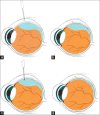A hybrid 26G needle drainage technique in scleral buckling: A mini scleral cut-down
- PMID: 36190054
- PMCID: PMC9789871
- DOI: 10.4103/ijo.IJO_760_22
A hybrid 26G needle drainage technique in scleral buckling: A mini scleral cut-down
Abstract
Purpose: To evaluate the efficacy and safety of hybrid 26-gauge needle drainage in scleral buckling for rhegmatogenous retinal detachment (RRD).
Methods: In this retrospective study, we included patients who underwent scleral buckling surgery along with subretinal fluid (SRF) drainage using the 'Hybrid 26G needle drainage technique'. Pre-operative assessment included the best corrected visual acuity (BCVA), lens status, and extent of retinal detachment. Intra-operative surgical details such as the height of retinal detachment, number of attempts required to drain the fluid, amount of fluid drained, adequacy of break buckle relationship, and any intra-operative or post-operative complications were noted. Post-operatively, the final visual outcome and retina status were assessed at 3 months of follow-up.
Results: A total of 10 eyes with primary RRD and proliferative vitreoretinopathy C1 or less were included. Pre-operatively, the mean BCVA was 2.43 ± 1.01 logMAR units, which improved significantly to 0.679 ± 0.45 logMAR units (p value < 0.05) at 3 months of follow-up. Regarding the extent of RRD, five eyes (50%) had a total detachment, two eyes (20%) had a sub-total detachment, and three eyes (30%) had an inferior detachment. Four eyes had shallow detachment, four had a moderate detachment, and two eyes had bullous detachment. Complete drainage of SRF (>75%) was achieved in five patients, and a partial but adequate drainage (50-75%) was achieved in the rest of the five patients. In none of the patients, inadequate or dry tap was encountered. No intra-operative complications were encountered. The retina was attached in eight out of ten eyes at 1 week and at a 1-month follow-up period. Two patients required pars plana vitrectomy for persistent SRF. The retina was attached in all the patients at 3 months of follow-up.
Conclusion: The 'Hybrid needle drainage' technique is a safe and effective technique for SRF drainage in scleral buckling surgery.
Keywords: External needle drainage; hybrid technique; rhegmatogenous retinal detachment; scleral buckling.
Conflict of interest statement
None
Figures

Similar articles
-
Internal drainage of subretinal fluid during scleral buckling with 27-Gauge wide angle viewing system and flute needle for rhegmatogenous retinal detachment.Int Ophthalmol. 2025 May 3;45(1):159. doi: 10.1007/s10792-025-03533-2. Int Ophthalmol. 2025. PMID: 40317397 Free PMC article. Clinical Trial.
-
[Influencing factors of visual prognosis in patients with persistent submacular fluid after successful scleral buckle surgery for macula-off retinal detachment].Zhonghua Yan Ke Za Zhi. 2023 Nov 11;59(11):899-905. doi: 10.3760/cma.j.cn112142-20230809-00030. Zhonghua Yan Ke Za Zhi. 2023. PMID: 37936358 Chinese.
-
EXTERNAL DRAINAGE OF SUBRETINAL FLUID DURING RHEGMATOGENOUS RETINAL DETACHMENT REPAIR.Retina. 2021 Sep 1;41(9):1828-1832. doi: 10.1097/IAE.0000000000003136. Retina. 2021. PMID: 33512898
-
Pars plana vitrectomy versus scleral buckling for repairing simple rhegmatogenous retinal detachments.Cochrane Database Syst Rev. 2019 Mar 8;3(3):CD009562. doi: 10.1002/14651858.CD009562.pub2. Cochrane Database Syst Rev. 2019. PMID: 30848830 Free PMC article.
-
Scleral Buckling Alone or in Combination with Pars Plana Vitrectomy for Rhegmatogenous Retinal Detachment Repair: A Meta-Analysis of 7,212 Eyes.Ophthalmologica. 2022;245(4):296-314. doi: 10.1159/000524888. Epub 2022 May 9. Ophthalmologica. 2022. PMID: 35533652
Cited by
-
An innovative external drainage device for suprachoroidal fluid: the puncture needle with drainage groove.Int J Ophthalmol. 2025 May 18;18(5):962-964. doi: 10.18240/ijo.2025.05.24. eCollection 2025. Int J Ophthalmol. 2025. PMID: 40385116 Free PMC article. No abstract available.
-
Internal drainage of subretinal fluid during scleral buckling with 27-Gauge wide angle viewing system and flute needle for rhegmatogenous retinal detachment.Int Ophthalmol. 2025 May 3;45(1):159. doi: 10.1007/s10792-025-03533-2. Int Ophthalmol. 2025. PMID: 40317397 Free PMC article. Clinical Trial.
References
-
- Johnston GP, Okun E, Boniuk I, Arribas NP. Drainage of subretinal fluid: Why, when, where and how. Mod Probl Ophthalmol. 1975;15:197–206. - PubMed
-
- Wilkinson CP, Bradford RH. Complications of draining subretinal fluid. Retina. 1984;4:1–4. - PubMed
-
- Azad R, Kumar A, Sharma YR, Rajpal Modified needle drainage. A safe and efficient technique of subretinal fluid drainage in scleral buckling procedure. Indian J Ophthalmol. 2004;52:211–4. - PubMed
-
- Bovino JA, Marcus DF, Nelsen PT. Argon laser choroidotomy for drainage of subretinal fluid. Arch Ophthalmol. 1985;103:443–4. - PubMed
MeSH terms
LinkOut - more resources
Full Text Sources
Medical
Miscellaneous

